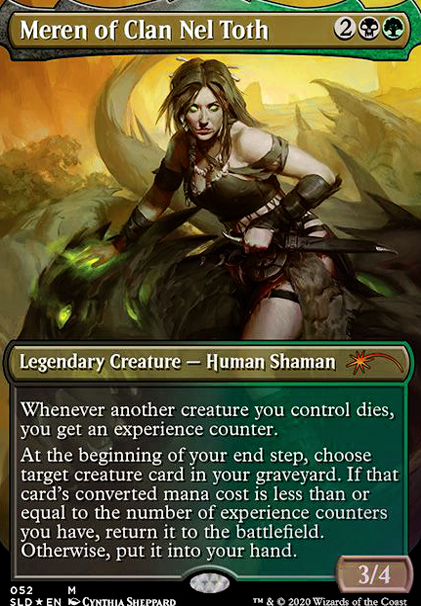
MEREN: THE CIRCLE OF LIFE AND DEATH【Primer】
Commander / EDH BG (Golgari) Combo Counters Dredge Infinite Combo Multiplayer Reanimator Sacrifice
Creature (41)
- 1x Birds of Paradise
-
1x
Carrion Feeder

-
1x
Caustic Caterpillar

- 1x Deathrite Shaman
-
1x
Elves of Deep Shadow

-
1x
Fyndhorn Elves

-
1x
Llanowar Elves

-
1x
Spore Frog

-
1x
Viscera Seer

- 1x Blood Artist
-
1x
Cankerbloom

-
1x
Dawntreader Elk

-
1x
Fauna Shaman

-
1x
Fiend Artisan

- 1x Hermit Druid
-
1x
Lesser Masticore

-
1x
Melira, Sylvok Outcast

-
1x
Sakura-Tribe Elder

-
1x
Satyr Wayfinder

- 1x Zulaport Cutthroat
-
1x
Eternal Witness

-
1x
Fierce Empath

-
1x
Fleshbag Marauder

-
1x
Grim Haruspex

-
1x
Midnight Reaper

-
1x
Plaguecrafter

- 1x Skullwinder
-
1x
Woe Strider

-
1x
Wood Elves

-
1x
Yahenni, Undying Partisan

- 1x Body Snatcher
-
1x
Foundation Breaker

-
1x
Ravenous Chupacabra

-
1x
Solemn Simulacrum

- 1x Yawgmoth, Thran Physician
-
1x
Gray Merchant of Asphodel

-
1x
Shriekmaw

-
1x
Sidisi, Undead Vizier

-
1x
Bane of Progress

-
1x
Massacre Wurm

- 1x Protean Hulk
Land (37)
-
1x
Blooming Marsh

- 1x Bojuka Bog
- 1x Command Beacon
-
1x
Command Tower

-
1x
Darkbore Pathway
 Flip
Flip
- 1x Dryad Arbor
-
1x
Fabled Passage

-
1x
Forest

- 3x Forest
-
1x
Forest

-
3x
Forest

-
2x
Forest

- 1x Geier Reach Sanitarium
-
1x
High Market

-
1x
Hostile Hostel
 Flip
Flip
-
1x
Llanowar Wastes

- 1x Nurturing Peatland
-
1x
Overgrown Tomb

- 1x Phyrexian Tower
-
4x
Swamp

-
4x
Swamp

-
1x
Temple of Malady

-
1x
Twilight Mire

-
1x
Urborg, Tomb of Yawgmoth

- 1x Verdant Catacombs
-
1x
Woodland Cemetery

Enchantment (3)
Commander (1)
Sorcery (7)
- 1x Reanimate
- 1x Life from the Loam
- 1x Bala Ged Recovery Flip
-
1x
Buried Alive

- 1x Toxic Deluge
-
1x
Victimize

-
1x
Living Death

Artifact (5)
Instant (4)
Planeswalker (2)
Maybeboard
Creature (44)
-
1x
Walking Ballista

- 1x Diligent Farmhand
- 1x Disciple of the Vault
- 1x Greenseeker
- 1x Krosan Wayfarer
- 1x Stitcher's Supplier
- 1x Sylvan Safekeeper
- 1x Apprentice Necromancer
- 1x Dawnstrider
- 1x Destiny Spinner
- 1x Devoted Druid
-
1x
Elvish Visionary

-
1x
Lesser Masticore

-
1x
Melira, Sylvok Outcast

- 1x Putrid Goblin
- 1x Riftsweeper
- 1x Silverglade Pathfinder
- 1x Soldevi Adnate
- 1x Vampire Hexmage
-
1x
Wall of Blossoms

-
1x
Winding Constrictor

-
1x
Demon's Disciple

- 1x Manglehorn
- 1x Merciless Executioner
-
1x
Ramunap Excavator

- 1x Reclamation Sage
-
1x
Stinkweed Imp

- 1x Thrashing Brontodon
- 1x Yavimaya Elder
- 1x Agent of Erebos
- 1x Bloodspore Thrinax
- 1x Mindslicer
- 1x Smothering Abomination
-
1x
Acidic Slime

-
1x
Golgari Grave-Troll

- 1x Syr Konrad, the Grim
-
1x
Kokusho, the Evening Star

-
1x
Mikaeus, the Unhallowed

- 1x Woodland Bellower
-
1x
Avenger of Zendikar

-
1x
Sheoldred, Whispering One

-
1x
Razaketh, the Foulblooded

-
1x
Terastodon

-
1x
Woodfall Primus

Land (8)
- 1x Grim Backwoods
- 1x Miren, the Moaning Well
- 1x Misty Rainforest
- 1x Prismatic Vista
- 1x Strip Mine
-
1x
Westvale Abbey
 Flip
Flip
- 1x Windswept Heath
- 1x Wooded Foothills
Artifact (3)
Sorcery (7)
Enchantment (4)
Instant (3)
Suggestions
Updates Add
Comments
Attention! Complete Comment Tutorial! This annoying message will go away once you do!
Important! Formatting tips — Comment Tutorial — markdown syntax
Please login to comment
Casual
93% Competitive
Revision 1 See all
(2 years ago)
| +1 | Cankerbloom | main |
| +1 | Lesser Masticore | main |
| +1 | Melira, Sylvok Outcast | main |
| Top Ranked |
|
| Date added | 4 years |
| Last updated | 2 years |
| Legality | This deck is Commander / EDH legal. |
| Rarity (main - side) | 8 - 0 Mythic Rares 42 - 0 Rares 17 - 0 Uncommons 12 - 0 Commons |
| Cards | 100 |
| Avg. CMC | 2.79 |
| Tokens | Experience Token, Goat 0/1 W, Insect 1/1 BG, Morph 2/2 C, Zombie 2/2 B |
| Folders | 1- BRAZATO EDH DECKS, stuff, Golgari/Witherbloom Decks |
| Votes | |
| Ignored suggestions | |
| Shared with | |
| Views |



 Art by Mark Winters
Art by Mark Winters
 INTRODUCTION
INTRODUCTION BRIEF DECK'S HISTORY
BRIEF DECK'S HISTORY STRATEGY
STRATEGY 1- PUTRID SOIL
1- PUTRID SOIL 2- OVERGROWN GRAVES
2- OVERGROWN GRAVES 4- THE LIFE AND DEATH CYCLE
4- THE LIFE AND DEATH CYCLE 4- LURKING HORRORS
4- LURKING HORRORS 5- CLOSING THE CIRCLE: WIN CONDITIONS
5- CLOSING THE CIRCLE: WIN CONDITIONS LORE
LORE